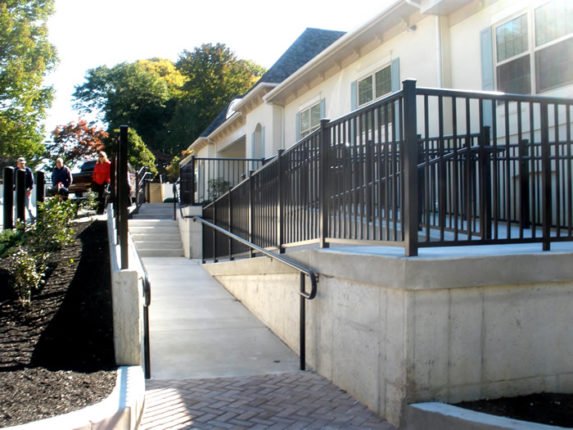In 1990, the Americans with Disabilities Act, typically called the ADA, was enacted to safeguard the rights of the disabled. One important part of the law requires that any building that the public is allowed to access must provide access for those who have mobility issues. The law covers a wide range of buildings, including government agencies, retailers, hotels and many apartment buildings.
Under the law, new buildings must be constructed to comply with the requirements of the ADA. Older buildings must be retrofitted to become ADA-compliant. Retrofits may include projects such as eliminating stairs that do not provide ramps or altering ramps that do not conform to the specifications included in the ADA.
ADA Concrete – Complex World of the ADA
Simply adding a ramp that a person in an electric scooter or wheelchair is allowed to use does not ensure compliance with the ADA. The ADA specifies how wide the ramp must be, how steep it can be and how long it can be before it reaches a landing. The size of the landing is also specified. In addition, the ADA specifies conditions that require the ramp to have curbing, side walls and/or handrails.
The ADA also addresses accessibility issues related to the parking lot. For example, if the path to the door is blocked by a curb, there must be a curb ramp to allow wheelchairs and scooters to transition from the parking lot to the entrance. In addition, the ADA describes the signage and pavement markings required for handicapped parking spaces as well as the size, location and number of handicapped spaces that are mandatory.
Given the complexity of the ADA, it is essential to work with a contractor who is knowledgeable about the law and who has experience in bringing properties into compliance. There have been companies that were fined or sued for non-compliance even though they hired a “professional” to ensure ADA-compliance. A single error — such as not making a landing the correct size or making a ramp with too great a slope — can be costly, normally requiring that the retrofit be demolished and rebuilt.
Why Choose Concrete for Your Ramps
The ADA allows access ramps to be built from several different materials, including concrete, aluminum, wood and fiberglass. However, the law also requires that the material not allow water to collect on the ramp, that the ramp be permanently affixed and that the ramp be slip-resistant. When these additional requirements are evaluated, concrete is the clear winner. It is naturally slip-resistant and will not absorb water. Furthermore, concrete has a much longer life than any of the other materials; with proper maintenance, a concrete ramp could last for a century or more. Concrete is also the only material that makes sense for curb ramps.
Let Alpha Paving Help Bring Your Property into Compliance
Alpha Paving is a full-service pavement company with extensive knowledge of the specifications contained in the ADA. Whether you need access ramps, curb ramps or pavement markings, we can help you bring your property into compliance. We work with municipalities, retailers, shopping malls, hotels, restaurants, office complexes, subdivisions, schools, churches, airports, HOAs, apartment complexes and warehouses throughout most of Central Texas. Our services include ramp construction, concrete curbing, asphalt paving, concrete repairs, asphalt overlays, asphalt repairs, sealcoating, parking lot striping, pavement markings, parking lot signs and many other pavement-related services. To request a free quote, call our office at (512) 677-9001 or fill out the online form.
Follow our Facebook page
Similar Post: Concrete Curbing




